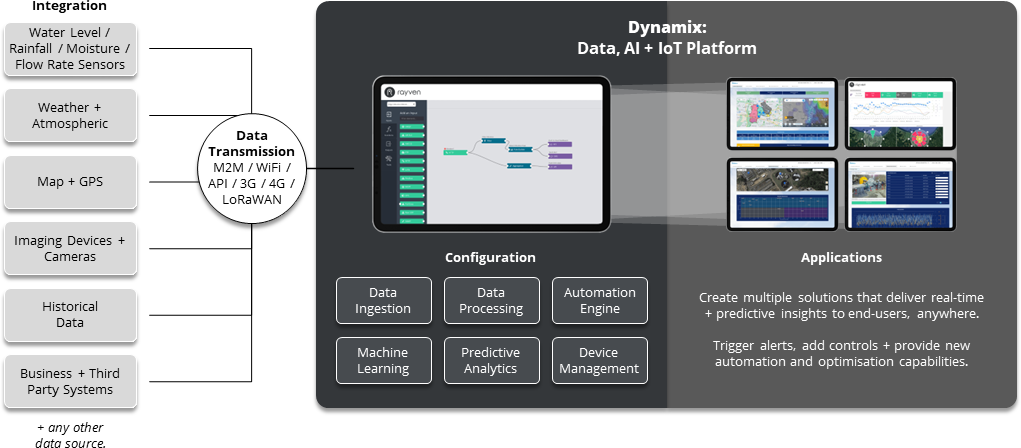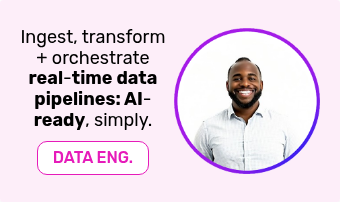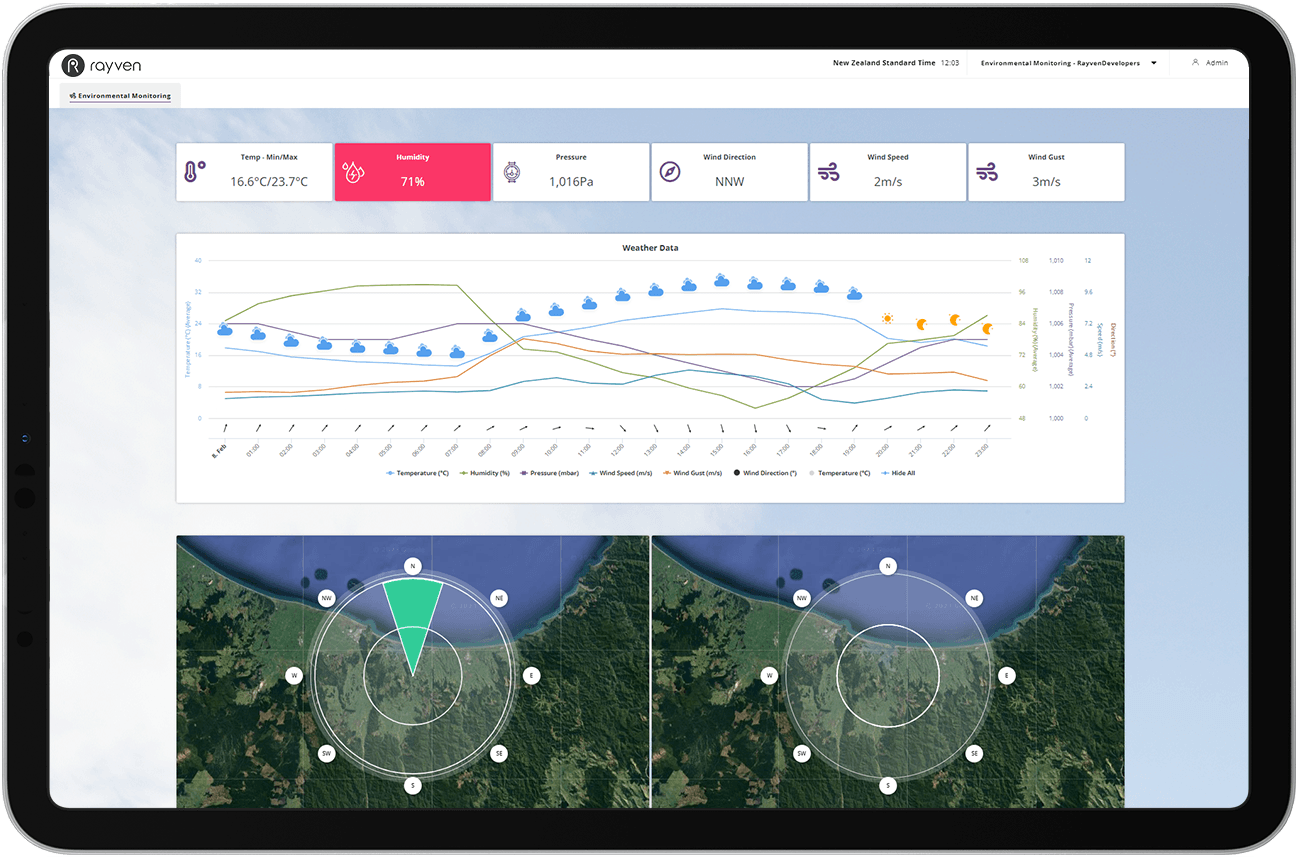Water Level + Flood Monitoring Solutions.
Monitor real-time water levels, predict needs + remotely mitigate risks, simply.
Easily customise and deliver a Water Level + Flood Monitoring solution that delivers safety, maintenance, ESG + bottom-line benefits, fast.
Monitor + manage real-time air quality and pollution with a custom, real-time solution.
Real-time monitoring of water levels and flood prediction for your site or across an entire region requires real-time data analysis from multiple data sources.
Use our Rayven Platform's Water Level + Flood Monitoring solution template as your starting point and integrate infield devices, third-party systems, and assets to deliver real-time and predictive insights on performance and how it can be improved.
Our all-in-one, easy-to-use technology comes complete with universal integration, machine learning, automation, and AI capabilities; enabling you to deliver real-time on how water levels are fluctuating, alert you to safety risks, predict future flows, direct you to higher-value mitigations + much more.
Remote, real-time water level monitoring.
Monitor water levels, speed + volumes across sites, simply. Integrate multiple data sources and sensors to get the complete, real-time view, anywhere.
Set thresholds + trigger alerts: make safety simple.
Set-up thresholds and trigger alerts. Use automation + control to alert employees, shutdown machinery, change signage, and activate assets to prevent flooding or lessen impact.
Build interactive dashboards + drill into trends.
Build custom dashboards to explore performance. Interrogate sources, analyse different factors, and spot trends hidden in Big Data.
Add custom AI + universal automation.
Our solution enables you to utilise inbuilt predictive analytics with your own and third-party data to predict outcomes and enable you to prevent compliance breaches.
Fits all existing
hardware + technologies.
Our Water Level + Flood Monitoring solution will integrate with any machinery, system, hardware, sensor, technology, or data repository - guaranteed.
Monitor more: add biomarkers, water quality, pH - anything.
Incorporate different in-field sensors + data sources to develop a complete, real-time view of water performance + enhance predictive modelling.
Rayven has free + low-cost options, making it affordable for every business.
How your Water Level + Flood Monitoring solution is put together.
New and existing data, (both real-time and historical), alongside custom logic, thresholds, and predictive analytics is used to create your custom Water Level + Flood Monitoring solution.

Our solution can handle data from anywhere in any format, and at all levels:
Level 1 Data: Manual entry of data via custom forms built within our solutions.
Level 2 Data: Bespoke spreadsheet ingestion via FTP or manual uploads.
Level 3 Data: Integration of real-time data from OT / IT systems and corporate systems.
Level 4 Data: Real-time integration with in-field technologies, asset systems + in-field sensors.
Your Water Level + Flood Monitoring solution will integrate with anything, including:
Water Level + Flood Monitoring solution FAQs.
Question: What is a Water Level + Flood Monitoring solution, and why is it important?
Given the increasing frequency and intensity of extreme weather events due to climate change, having a robust and effective solution is crucial for both businesses and governments in order to safeguard people, critical assets, and to maintain operational standards.
A flood monitoring solution is a system that uses interconnected devices, sensors, and software to monitor water levels in real-time and predict flooding. Advanced systems also offer additional capabilities enabling you to adjust watercourse settings, manage pumps and other remote assets, enabling people mitigate risks and increase worker safety.
Question: What's involved in a Water Level + Flood Monitoring solution?
Water level and flood monitoring requires a system of interconnected devices, sensors, and software platforms used to monitor, analyse, and manage risks. Here's how it can work:
- Sensors: Specialised sensors can measure a range of environmental factors, such as:
- Water Level Sensors: Measure the water levels in rivers, dams, reservoirs, or other bodies of water to detect rising levels that could lead to flooding.
- Rainfall Gauges: Measure the amount of rainfall in an area, providing data that can help predict potential flooding based on the rate of precipitation.
- Soil Moisture Sensors: Measure the moisture content in the soil, which can indicate the soil's capacity to absorb more water and the potential for flash floods.
- Flow Rate Sensors: Determine the speed and direction of water flow in rivers and streams, which can indicate how rapidly water levels might rise in downstream areas
- Data collection + transmission: These sensors collect data continuously or at set intervals. The data is then transmitted wirelessly to a central server or SaaS-based platform. Advanced platforms can handle data from thousands of sensors simultaneously.
- Real-time data analysis: Advanced platforms (like Rayven's) analyse the data to generate an accurate picture of current conditions in real-time. Patterns and trends can be identified using historical data analysis, which can inform decision-making.
- Data visualisation: Data visualisation via the platform's dashboards and/or applications can provide water level and flood maps to end users, simply. These can be updated in real-time based on actual conditions.
- Machine Learning + predictive analytics: An advanced platforms will have inbuilt capabilities to analyse multiple data sources, both real-time and historical, to predict future water levels and predict flooding based on weather (and other) data. Operators can then use the data to make better decisions via both human and AI.
- Responsive actions + alerts: In advanced setups, the system can be integrated with communication systems and infield assets, such as pumps, sluices and drainage courses. These will allow you to alert personnel infield as to risks, as well as allowing you to take action to mitigate potential problems remotely without having to put people in harms way.
- Application(s): Some platforms (like ours) can support worker, regulatory and public-facing apps and dashboards that deliver critical insights to anyone that needs them, wherever they are.
Question: How can real-time water level + flood monitoring help businesses?
For businesses, where even minor disruptions can result in significant financial losses and reputational damage, real-time water level and flood monitoring offers a critical line of defence. By leveraging these systems, businesses can operate with a higher degree of predictability and security, even in regions prone to frequent flooding.
Real-time water level and flood monitoring can deliver significant benefits:
- Prevent defences becoming overwhelmed: Enables you to make informed decisions based on real-time data, optimising response and resource allocation, activating machinery, thereby offering the potential to prevent flooding.
- Business/service continuity: Early flood warnings allow businesses to initiate their disaster recovery and business continuity plans promptly, ensuring minimal disruption to operations.
- Asset protection: Enables timely measures to safeguard critical assets, machinery, and inventory from flood damage. This can include moving assets to higher ground or deploying protective barriers.
- Safety: Protecting people is paramount. Real-time monitoring allows businesses to evacuate employees and communities from areas at risk, ensuring their safety.
- Supply chain management: Floods can disrupt transportation routes, impacting both supply of raw materials and delivery of finished goods. Advance warning can help businesses adjust logistics strategies, find alternative routes, or reschedule shipments.
- Financial preparedness: By anticipating potential floods, businesses can inform insurance providers, make necessary claims preparations, and allocate funds for potential recovery efforts.
- Environmental responsibility: Some sites may contain hazardous materials. Real-time monitoring can help businesses take measures to prevent these materials from contaminating floodwaters, thereby preventing environmental disasters.
- Infrastructure + equipment maintenance: Predictive data can guide businesses in shutting down vulnerable equipment, minimizing damage and reducing post-flood restoration efforts and costs.
- Stakeholder communication: Proactive communication with stakeholders, including investors, clients, and the public, can be initiated based on real-time data. This transparency can help manage expectations and maintain trust.
- Regulatory compliance: In many regions, businesses have legal obligations to manage and mitigate their flood risks. Real-time monitoring can ensure compliance with these regulations and avoid potential legal and financial repercussions.
- Operational decisions: In the face of impending floods, businesses can decide whether to ramp down production, store finished products, or even move critical operations to another location.
- Reputation management: By effectively managing and mitigating flood risks, businesses can uphold their reputation by showcasing resilience, environmental responsibility, and a commitment to employee and community safety.
Question: What are the key features to look for in a Water Level + Flood Monitoring solution?
When selecting a solution, it's critical to explore the following capabilities:
- Real-time data processing: The platform needs to be capable of processing vast amounts of data from various sensors in real-time, as well as providing insights, predictions, and alerts based on set parameters.
- Scalability: Ability to handle data from multiple sensors, systems and third-party systems spread across large areas. Expandability to accommodate growth in monitoring infrastructure and different sites - without blowing out costs.
- Data visualisations: Advanced, prebuilt tools for visualising data in multiple ways in order to make it usable by different end users.
- Machine Learning + predictive analytics capabilities: Critical for delivering forecasts and advanced warnings of risks.
- Integration: compatibility with other IoT systems, legacy business systems, as well as external data sources and SaaS. API support for custom integrations and applications.
- Geo-tagging + mapping: Precise location data and visualisation capabilities using maps for spatial understanding of different environments.
- Secure data transmission: Encryption and secure protocols to protect data integrity. Measures to prevent unauthorized access.
- Alerting + notification system: Customisable thresholds for alerts. Multiple notification channels (email, SMS, app notifications).
- Remote control, configuration + device management: Ability to adjust sensors and other machinery remotely. Over-the-air updates for firmware and software.
- Cloud connectivity + storage: Data stored in a secure cloud environment. Easy access to historical data and trends.
- User-friendly, fully-customisable interfaces: Intuitive dashboards and reporting tools, tailorable for different uses. Mobile access for on-the-go monitoring.
- Regulatory + standard compliance: Ability to demonstrate adherence to industry standards and regulations.
Question: What industries and organisations can benefit from an Water Level + Flood Monitoring solution?
A Water Level + Flood Monitoring solution offers value to a variety of industries and organisations due to its potential in risk mitigation, operational efficiency, and safety enhancement. Here are some sectors and entities that can greatly benefit from such a solution:
- Environmental: For monitoring wetlands, estuaries, and other ecologically sensitive areas vulnerable to flooding.
- Agriculture: Helps farmers manage irrigation, anticipate water logging, and protect crops from flooding.
- Utilities: Water supply and treatment plants, power stations, and other critical utilities can be safeguarded from flood damage.
- Transportation + Logistics: For managing and rerouting transport routes, especially in areas prone to flash floods or consistent water logging.
- Industrial Plants + Factories: Protect machinery, assets, and ensure operational continuity by anticipating flood events.
- Mining: Mines can be vulnerable to flooding, especially during heavy rainfall. Monitoring helps ensure safety and operational continuity.
- Energy: hydroelectric power plants, refineries, and other energy infrastructures can be safeguarded and operations optimised using flood data.
- Ports + Harbours: For managing ship movements, safeguarding goods, and ensuring the safety of the infrastructure.
- Forestry + Wildlife Management: Monitoring helps protect wildlife habitats from flooding and assists in forest management.
- Public Parks + Recreational Facilities: For safeguarding infrastructure and ensuring visitor safety.
- Construction: Developers can assess flood risks for potential construction sites, while existing properties can be better managed with early flood alerts.
- Government + Public Sector: For city planning, infrastructure management, and emergency response coordination.

































